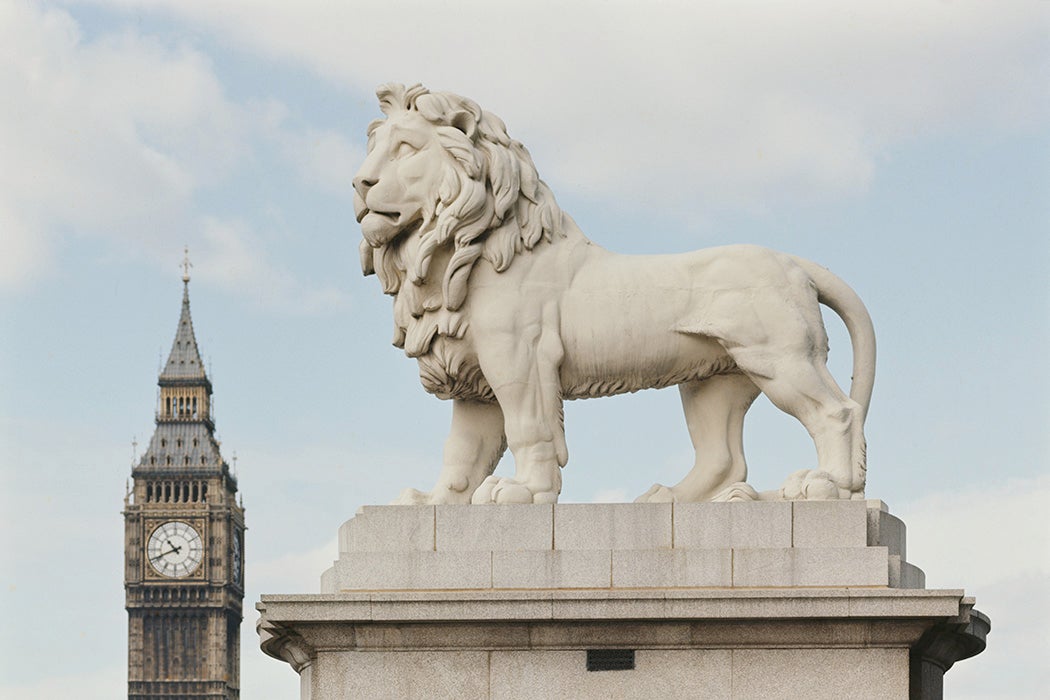Considering that masonry, marble, and limestone take an awful beating from weather and pollution, it’s surprising how well many imposing Georgian buildings, statues, and monuments have held up after more than two hundred years. What’s going on here?
It turns out that the stone decoration of that period wasn’t necessarily natural. The late eighteenth and early nineteenth centuries were the heyday of Coade stone, an architectural ceramic that looked like finely grained stone, now considered even more durable than the better-known terra cotta. Coade stone was named for Eleanor Coade, who founded the company that manufactured it in 1769 in Lambeth, London. This early case of good branding was unusual because not many women ran such successful “works” in that time.
The architectural style known as classical revival—based on then-current ideas of what the Greeks and Romans had been up to—demanded decorative repetition. But it took a very un-classical factory to mold standard patterns and architect-designed pieces with precision uniformity. Coade and her daughter, also named Eleanor, ran the business for more than thirty years.
“Durable, relatively inexpensive and easily workable, Coade stone admirably fulfilled the aesthetic requirements of the era and was an immediate commercial success,” write Martin Feely, Jerry Lidwill, and Dominic Monaghan in their study of the artificial stone’s use in Ireland.
Coade stone, the authors write, satisfied architects’ voluminous decorative needs: “Statues, pediments, columns, bases, capitals, medallions, plaques, vases, porticoes, quoins, reliefs, balustrades, fountains, gateways and entablatures were made to order by Mrs. Coade’s craftsmen and shipped to such destinations as Canada, Australia and Brazil.”
Some even made it to the United States. The front columns and chimneypiece of Washington, D.C.’s Octagon House, a historic landmark that was the temporary residence of James Madison after the British attack on the capital in 1814, are imported Coade stone. Back in London, the most prominent Coade stone product on the tourist’s radar might well be the South Bank Lion, located at the eastern end of Westminster Bridge. The statue was made in 1837 to advertise the Lion Brewery.
Feely et al. note that “an air of mystery surrounds the manufacture of Coade stone,” but the the ingredients if not the exact formula seem to have been “widely known throughout the trade.”
Coade stone was a mixture of white clay, crushed ceramic (“grog”), flint, sand, and glass. The mix was poured into moulds before being fired in kilns. Eleanor Coade senior called her product “lithodiprya,” meaning “stone twice fired” because of the recycled grog and glass, both previously created with high heat. (Contemporary sculptor and restorer Philip Thompson attempted to recreate Coade stone using an old industrial dough mixer.)
Weekly Newsletter
Art historian Alison Kelly tracked down uses of Coade stone in cities, country houses, and gardens. She writes that the elder Eleanor Coade’s achievement was “in obtaining commissions from practically every major architect of her time.” But, notes Kelly, the Coades were long under-appreciated because their product was “normally mistaken for carved natural stone.” Later generations thought it was in fact stone, and thus no big deal.
And like many building elements over time, Coade stone lost its fashionable appeal. The Victorians liked their decorative ceramics to look like ceramics, shiny and terra cotta red. The Coade factory dwindled in production until about 1840, both Coade women having since passed from the scene. The unique characteristics of their artificial stone meant it could survive them by centuries, even if it took later generations a while to realize it.
Support JSTOR Daily! Join our new membership program on Patreon today.







